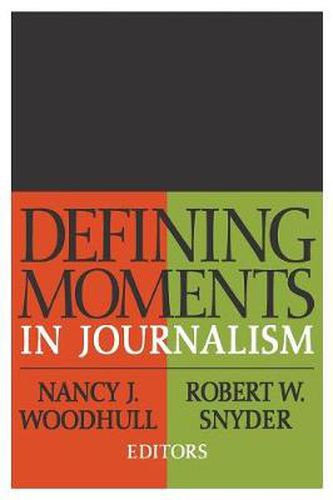Readings Newsletter
Become a Readings Member to make your shopping experience even easier.
Sign in or sign up for free!
You’re not far away from qualifying for FREE standard shipping within Australia
You’ve qualified for FREE standard shipping within Australia
The cart is loading…






Most great transformations are not apparent as we live through them. Only in hindsight do individual moments acquire layers of meaning that give them great significance. Looking back is not something that comes naturally to journalists, immersed as they are in breaking events and relentless deadlines. But there is still good reason for journalists, scholars, and people who care about journalism to think about the critical episodes in its recent evolution. In Defining Moments in Journalism, such authors vividly describe episodes of this kind.
Some of the chapters and contributors include: The Lessons of Little Rock by Harry S. Ashmore; Vietnam and War Reporting by Peter Arnett; Photo-journalists–Visionaries Who Have Changed Our Vision by Jane M. Rosett; The Weight of Watergate by Ellen Hume; Women Sportswriters–Business as Usual by Mary Schmitt; The Connie Chung Phenomenon by Somini Sengupta; and Covering Politics–Is There a Female Difference? by Judy Woodruff.
The years since the Great Depression and World War II have seen vast changes in America and also in its journalism. Journalists’ relationship to power and authority is more complex; the press corps has become more diverse; the technology of news reporting is almost unrecognizably different from that of fifty years ago; and economic reorganization of the media has bundled news and entertainment organizations into conglomerates of extraordinary size. Defining Moments in Journalism is a fascinating read for communications scholars and professionals, historians, and political scientists.
$9.00 standard shipping within Australia
FREE standard shipping within Australia for orders over $100.00
Express & International shipping calculated at checkout
Most great transformations are not apparent as we live through them. Only in hindsight do individual moments acquire layers of meaning that give them great significance. Looking back is not something that comes naturally to journalists, immersed as they are in breaking events and relentless deadlines. But there is still good reason for journalists, scholars, and people who care about journalism to think about the critical episodes in its recent evolution. In Defining Moments in Journalism, such authors vividly describe episodes of this kind.
Some of the chapters and contributors include: The Lessons of Little Rock by Harry S. Ashmore; Vietnam and War Reporting by Peter Arnett; Photo-journalists–Visionaries Who Have Changed Our Vision by Jane M. Rosett; The Weight of Watergate by Ellen Hume; Women Sportswriters–Business as Usual by Mary Schmitt; The Connie Chung Phenomenon by Somini Sengupta; and Covering Politics–Is There a Female Difference? by Judy Woodruff.
The years since the Great Depression and World War II have seen vast changes in America and also in its journalism. Journalists’ relationship to power and authority is more complex; the press corps has become more diverse; the technology of news reporting is almost unrecognizably different from that of fifty years ago; and economic reorganization of the media has bundled news and entertainment organizations into conglomerates of extraordinary size. Defining Moments in Journalism is a fascinating read for communications scholars and professionals, historians, and political scientists.